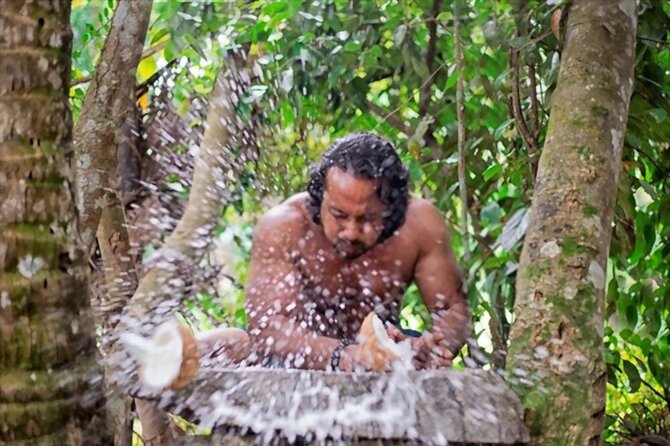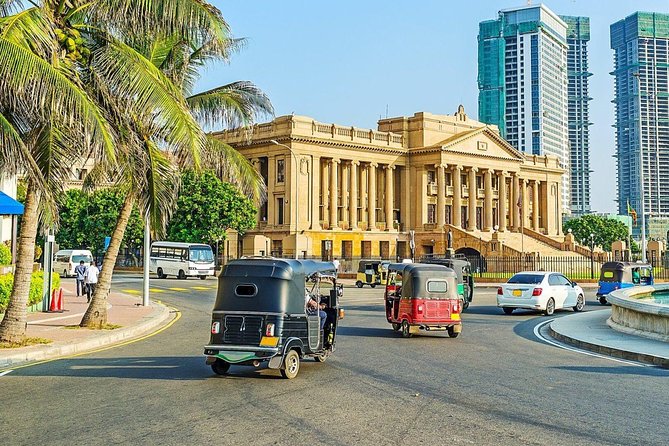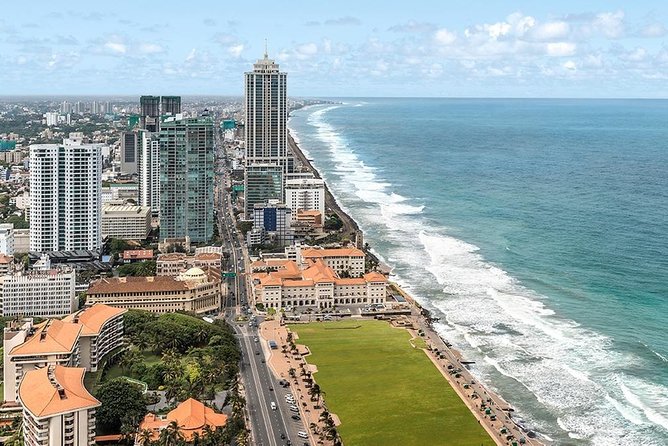Exploring the world of Angampora unveils a rich tapestry of history, technique, and cultural significance deeply rooted in Sri Lanka’s heritage. The intricate blend of physical prowess and spiritual discipline in this martial art captivates enthusiasts and historians alike, offering a glimpse into a realm where combat and tradition intertwine seamlessly. As practitioners master the art of Angampora, they not only hone their physical skills but also enjoy a tradition that transcends mere combat, embodying a legacy that continues to inspire and intrigue.
Good To Know

- Angampora is a traditional Sri Lankan martial art with deep historical significance.
- Training includes physical conditioning, meditation, a variety of strikes, and defensive strategies.
- Traditional weapons like ethunu kara, illangata, and staves are integral to Angampora.
- Angampora is culturally relevant, embodying Sri Lankan values, beliefs, and history.
- Masters play a crucial role in preserving Angampora’s lineage and passing down knowledge.
Historical Significance of Angampora

With roots tracing back centuries, Angampora, the traditional Sri Lankan martial art, holds a rich historical significance in the cultural tapestry of the island nation. Originating in the ancient kingdoms of Sri Lanka, Angampora was practiced by the indigenous people as a means of self-defense and combat training.
This martial art not only honed physical combat skills but also encompassed spiritual and mental aspects, emphasizing discipline and respect. Through the generations, Angampora has been passed down from master to student, preserving its techniques and traditions.
The practice of Angampora has played a vital role in shaping Sri Lankan history, reflecting the resilience and strength of its people. Today, Angampora stands as a testament to the country’s enduring heritage and martial prowess.
Find more activities and experiences we've covered in Colombo.
Training and Techniques
Exploring the intricate training methods and combat techniques of Angampora reveals a dynamic fusion of physical agility and mental acuity. Practitioners undergo rigorous physical conditioning, focusing on strength, flexibility, and endurance.
Training sessions often start with meditation to sharpen the mind and cultivate focus. Techniques encompass a wide array of strikes, kicks, joint locks, and throws, emphasizing fluidity and precision in movements. Students also learn defensive strategies, including blocks and counters, to effectively neutralize attacks.
Angampora’s training methodology emphasizes a holistic approach, incorporating both offensive and defensive tactics. The art’s techniques are passed down through generations, with experienced instructors guiding students in mastering the intricate skills required for this traditional Sri Lankan martial art.
Weapons Used in Angampora

In Angampora, practitioners skillfully wield an array of traditional weapons that add a unique dimension to this ancient Sri Lankan martial art. Among the weapons commonly used are the ethunu kara (a long staff), illangata (a double-edged sword), and the staves known as pol kattha and staves.
The ethunu kara, often made of wood or metal, is versatile for both offense and defense, requiring agility and precision. The illangata demands expertise due to its sharp edges and intricate handling techniques. The pol kattha and staves are used for close combat, testing the warrior’s speed and reflexes.
These weapons not only showcase the rich heritage of Angampora but also highlight the skill and dexterity required in mastering this traditional Sri Lankan martial art.
Cultural Relevance

Practicing Angampora not only hones combat skills but also serves as a cultural tribute, deeply rooted in the heritage of Sri Lanka. This traditional martial art form isn’t just about physical techniques; it embodies the values, beliefs, and history of the Sri Lankan people.
Through Angampora, practitioners pay homage to their ancestors who passed down this knowledge through generations, preserving a vital aspect of their cultural identity. The rituals, clothing, and weapons used in Angampora all hold significance in Sri Lankan history, reflecting the country’s rich cultural tapestry.
Masters and Lineage
Mastering Angampora requires dedication and skill, as practitioners aim to uphold the lineage of revered martial arts masters in Sri Lanka.
In this rich martial art tradition, the mastery and lineage are deeply respected and passed down through generations.
Here are three key points about Angampora masters and lineage:
Historical Lineage: Angampora traces its roots back to ancient Sri Lankan warriors who honed their skills in combat and passed down their knowledge through generations.
Master-Disciple Relationship: The relationship between a master and disciple in Angampora is sacred, with the master imparting not only physical techniques but also wisdom and values.
Preservation of Heritage: Angampora masters play a crucial role in preserving the cultural heritage of Sri Lanka by safeguarding and transmitting this martial art to future generations.
Rituals and Traditions
Angampora’s rich martial art tradition is intricately woven with a tapestry of rituals and traditions that add depth and meaning to the practice.
Before any training session begins, practitioners pay homage to their ancestors and seek blessings for protection and guidance. This ritual, known as ‘Guru Pooja‘, sets a reverent tone for the training ahead.
The use of traditional weapons like the ‘Paththu‘ (sword) and ‘Ilu Gala‘ (spear) isn’t merely physical but also carries symbolic significance, linking the present practitioners to their warrior ancestors.
Respect for one’s opponent is deeply ingrained in Angampora, with rituals emphasizing the importance of honor and integrity in combat.
These traditions not only enrich the martial art form but also instill a sense of cultural pride and identity in its practitioners.
Modern Adaptations
Incorporating modern training techniques and technology has allowed practitioners of this traditional Sri Lankan martial art to enhance their skills and adapt to contemporary challenges. To shed light on the modern adaptations of Angampora:
Use of High-Tech Equipment: Angampora schools now integrate modern training gear like focus mitts and agility ladders to improve speed and precision.
Fitness and Conditioning Programs: Incorporating elements from modern fitness routines such as strength training and cardio workouts has become common practice among Angampora practitioners.
Online Learning Platforms: Some instructors have embraced virtual platforms to offer tutorials and training sessions, enabling students worldwide to learn this ancient art form.
Preserving the Art
Preserving the ancient art of Angampora is crucial for passing down its rich heritage to future generations. To ensure the survival of this traditional Sri Lankan martial art, efforts are being made to document and teach Angampora techniques to younger practitioners.
Training centers and workshops have been established to educate enthusiasts about the history, philosophy, and combat strategies of Angampora. Experienced masters are actively involved in mentoring students and organizing events to showcase the art’s unique techniques and cultural significance.
Frequently Asked Questions
Can Beginners Participate in Angampora Training?
Beginners can participate in angampora training. They will receive guidance from experienced instructors, learning the techniques and history of this traditional Sri Lankan martial art. The training provides a unique and immersive experience for all skill levels.
Are There Any Age Restrictions for Learning Angampora?
There are no specific age restrictions for learning Angampora. It’s a martial art that welcomes participants of various ages. Beginners, regardless of age, can explore and train in this traditional Sri Lankan martial art.
How Long Does It Take to Become Proficient in Angampora?
Becoming proficient in Angampora varies based on individual dedication and skill level. Regular practice, commitment, and guidance from experienced instructors are key factors. Progress can be seen within months, but mastery typically requires years of training.
Is Angampora Recognized as an Official Sport in Sri Lanka?
Angampora is not officially recognized as a sport in Sri Lanka. Despite its historical significance and cultural value, efforts are ongoing to gain official recognition for Angampora as a legitimate martial art and sport in the country.
Are There Any Specific Dietary Requirements for Angampora Practitioners?
For Angampora practitioners, there are no specific dietary requirements. However, maintaining a balanced diet rich in proteins, carbohydrates, and essential nutrients can support their physical training and overall performance in this traditional Sri Lankan martial art.
The Sum Up
To sum it up, Angampora stands as a testament to Sri Lanka’s rich cultural heritage, combining physical prowess with mental and spiritual discipline.
With its deep historical roots, diverse techniques, and unique weaponry, Angampora continues to be a revered martial art that reflects the values and traditions of the Sri Lankan people.
By preserving and practicing this ancient art form, individuals not only honor their ancestors but also ensure that the legacy of Angampora lives on for generations to come.
More Tour Reviews in Colombo
Looking for something different? Other Colombo activities we've written about
- Mirissa Whale watching, Stilt Fishing & Turtle Tour From Colombo
- Colombo City Tour
- Colombo City Tour
- Sigiriya Lion Rock & Dambulla Cave Temple Day Tour From Colombo
- Wilpattu National Park Private Jeep Safari From Colombo & Negombo
- Sigiriya Rock & Cave Temple With Jeep Safari Private Day Trip
- All-Inclusive Day Tour of Sigiriya & Dambulla From Colombo
- Private Night Tour in Colombo With Street Food Tasting
- Colombo City Tour
- All Inclusive Kandy Private Day Tour From Colombo and Negombo
- Yala National Park Private Jeep Safari From Colombo & Negombo
- Muthurajawela Bird Watching Tour From Colombo & Negombo
